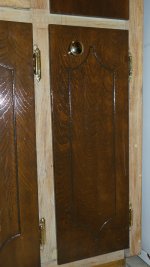Hi Everyone,
I've had an ETS 125 for about 5 years now and just bought an RO 90 DX in preparation for refinishing some kitchen cabinet doors that I refinished about 5 years ago with a stain and water based polyurethane. They were/are in terrible condition, but it's a rental so I have no choice at the moment. I never got around to finishing the frames. My refinishing experience is very limited.
This time, I wish to prime them with Benjamin Moore Fresh Start and paint them with Benjamin Moore Satin Impervo. I've ordered abrasives for the ETS 125 and RO 90 DX in the sanding sequence of 80-120-150-180 and then 220 between primer and first coat, and finally 320 for between first and second finish coats. The guy at my local Benjamin Moore was telling me that I should start with 100 instead of 80 so that I don't lose the detail in my cabinets. I have already ordered the 80. Before I drop more $$$ for 100 grit, is there really a big difference between starting the sanding sequence on finished cabinets with 100 or 80? I've not yet found much information on the differences between 80 and 100 that applies to refinishing cabinets with some detail.
Finally, if it's ok to start at 80, is it then OK to jump to 120? Or should I not skip any like I've been reading?
Thank you for any help! [wink]
I've had an ETS 125 for about 5 years now and just bought an RO 90 DX in preparation for refinishing some kitchen cabinet doors that I refinished about 5 years ago with a stain and water based polyurethane. They were/are in terrible condition, but it's a rental so I have no choice at the moment. I never got around to finishing the frames. My refinishing experience is very limited.
This time, I wish to prime them with Benjamin Moore Fresh Start and paint them with Benjamin Moore Satin Impervo. I've ordered abrasives for the ETS 125 and RO 90 DX in the sanding sequence of 80-120-150-180 and then 220 between primer and first coat, and finally 320 for between first and second finish coats. The guy at my local Benjamin Moore was telling me that I should start with 100 instead of 80 so that I don't lose the detail in my cabinets. I have already ordered the 80. Before I drop more $$$ for 100 grit, is there really a big difference between starting the sanding sequence on finished cabinets with 100 or 80? I've not yet found much information on the differences between 80 and 100 that applies to refinishing cabinets with some detail.
Finally, if it's ok to start at 80, is it then OK to jump to 120? Or should I not skip any like I've been reading?
Thank you for any help! [wink]

